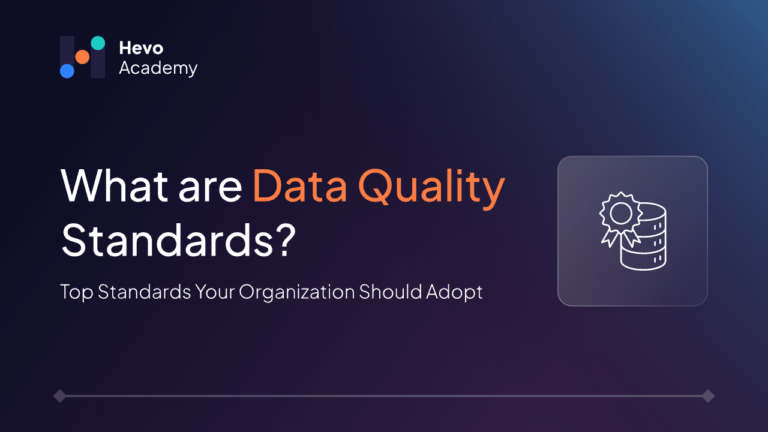Data quality is an important part of any data strategy. It is important to make accurate and right decisions. According to a 2020 report by Gartner, poor data quality can cost an organization on average up to $12.9 million annually. Poor data quality can lead to deriving wrong can interpretations, misguided business strategies, and financial losses. This means that all your investments in data strategy can be unsuccessful.
Table of Contents
In this article, we explore different data quality dimensions, how we can maintain data integrity, and how to measure data quality.
What is Data Quality?
Data Quality is a state of data where it fulfills the purpose in a particular context. Data Quality can be classified as poor or high quality in comparison to standards defined for the intended use.
It is an important part of data management that directly affects business processes, decisions, and the overall performance of any company. High-quality data empowers businesses to make better decisions based on the data.
What is the Data Quality Dimension?
Data Quality Dimensions are various tangible features or characteristics of data that can be used to evaluate it. Different organizations may have different dimensions to their data that are relative to their purpose. These dimensions help in standardizing the framework for assessing whether the data serves the objectives. For assessing the quality it is also important that these dimensions are measurable. Among the various data quality dimensions, integrity and validity stand out as critical for ensuring that data is complete, reliable, and suitable for analysis.
In a study published by Harvard Business Review, on average only 3% of the company’s data meet the required standards. 47% of newly created records have at least 1 critical error. From these stats the problem is simple, organizations need regular on-the-fly data quality checks to ensure the quality of their data. To achieve this, the Dimensions of their data must be clearly identified and defined
What are the 6 Dimensions of Data Quality?
In the above section, we discussed Data Quality Dimensions and their use. Now let’s take a look on what are some generic dimensions that are relevant to most of the use cases.
1. Accuracy
Data accuracy is a key component of data quality. It depicts how well data represents the real world. Accurate data is correct, reliable, and error-free. According to Harvard Business Review study, 47% of failed business decisions are due to poor data accuracy.
For example, if a user has added the wrong city and correct PIN code in the address field. This can lead to ambiguity and delivery service thinking on where to deliver the product.
2. Completeness
Data completeness is the degree that measures if all the necessary data is present. According to a KPMG report, 60% of organizations face incomplete data as a main quality challenge. Missing data can lead to incomplete analysis and hence wrong decisions.
For example, If the delivery address does not have a PIN code, it can lead order getting delivered to the wrong place.
3. Consistency
Data consistency is a measure of data quality that checks data is uniform across the systems. Data inconsistencies can occur if the same data is stored differently across various systems and is not synced. According to research by IBM, inconsistent data could lead to operational inefficiencies, costing businesses an average of 15% of their annual revenues.
For example, revenue data for the current month is being loaded from the lake to the data warehouse for dashboarding purposes, due to data leakage some records get missing during the transfer. This can lead to a false depiction of an organization’s earnings for that month.
4. Timeliness
Data Timeliness ensures that data is always up-to-date and available when required. Outdated data can distort analysis. Data timeliness is extremely important in areas of Healthcare and self-driving cars. A McKinsey report showed that real-time data availability can improve decision-making by up to 24%.
For example, due to some data pipeline failures, doctors are not able to receive real-time analysis of the heart rate of a patient. In emergencies, this could cause loss of life.
5. Validity
Data validity is a data quality measure that checks if data complies with the required formats and business rules. Invalid data often leads to operational disruptions. A survey by Experian found that 89% of companies identify data validity as crucial to business outcomes.
Among various data quality dimensions, data reliability and validity stand out as foundational for accurate analytics, as they confirm that data is both consistent over time and accurate in context. For example, the standard of storing financial amounts for a company is in dollars using K but accidentally someone feeds the euros figures into the table. This could lead to a huge loss in calculation and hence revenue
6. Uniqueness
Data Uniqueness ensures that there is no duplication within a dataset. Duplicate data not only wastes resources but also complicates the analysis. A recent survey by Salesforce highlighted that 30% of businesses get affected due to duplicate and poor data quality.
For example, due to a programmatic issue, a double-order entry is created in database. This could lead to double the amount of product getting delivered to the customer and Hence loss to the company.
How to Ensure Data Quality and Integrity?
Where Data Quality measures if the data meets the decided standards, data integrity makes sure that data is reliable. To achieve both it is important to implement data quality checks. Below we have discussed some ways to implement data quality checks.
- An automated data profiling process can be implemented to identify errors. This process should be scheduled to ensure regular evaluation.
- Data cleaning tools can help remove duplicates and address missing data
- Implement a strong data governance framework that has clear guidelines on accessing, storing, and using data.
- Define clear roles and accountability of data to ensure data is accessible to the right hands.
- Apply standard format checks before storing data.
- Implement business rules on certain data fields and columns to restrict the range of values that can be inserted.
- Add a metric to store the information refreshed in the last table. This can help keep track of when the last data was updated to identify freshness or recency of data.
How to Perform Data Quality Measurement?
To perform data quality measurement organizations must create a data quality assessment checklist around the key dimensions. This can help them ensure that their data meets specific standards. Below we discuss a few metrics that can be used to measure data quality.
| Data Dimension | Data Quality Metric | Formula | Definition |
| Accuracy | Erroneous data percentage | Total inaccurate records/total number of records | Measures how many errors exist as compared to the total size of the dataset. High-accuracy data is relevant to real-world scenarios. |
| Completeness | Number of Empty Values | Total incomplete records/total number of records | Indicates how much data is missing. Complete data ensures all necessary fields are filled with meaningful values. |
| Consistency | Consistency Measure | Total inconsistent records/ total number of records | Reflects how many same records contain different information. Consistent data means uniformity across different sources. |
| Timeliness | Data Time-to-Value | Total timely records/ total number of records | Assesses how timely data reaches its decided destination. Timely data ensures up-to-date information is available for decision-making. |
| Validity | Amount of Expired Data | Total invalid records/ total number of records | Measures how many records do not meet predefined standards. |
| Uniqueness | Duplicate Percentage | Total non-unique records/ total number of records | Indicates how many records are duplicated. Unique data means each entity is represented once. It helps to prevent redundancies. |
These metrics offer a structured way to assess data quality so that you can maintain integrity of your data.
Conclusion
Various case studies have been done to showcase how data quality significantly impacts businesses. With organizations relying on data to grow their businesses, it has become important to maintain data quality. The first step to achieving quality is to identify data dimensions that are relevant to their use case. In the above sections, we discussed the key dimensions of data quality i.e. accuracy, completeness, consistency, timeliness, validity, and uniqueness. These dimensions can be used to create a data quality checklist which can regularly be used to measure and monitor the health of your data.
FAQ
1. What are the 7 dimensions of data quality?
The seven dimensions of data quality include accuracy, completeness, consistency, timeliness, validity, uniqueness, and integrity.
2. What are the 7 C’s of data quality?
The 7 C’s of data quality are Cleanliness, Completeness, Consistency, Conformity, Credibility, Currentness, and Confidentiality.
3. What are the 7 dimensions of product quality?
The 7 dimensions of product quality are performance, features, reliability, conformance, durability, serviceability, and aesthetics. These dimensions help evaluate how well a product meets customer needs and expectations.






